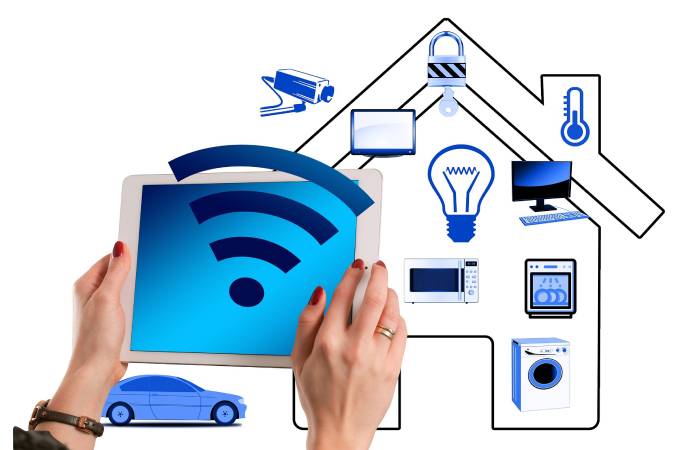Electronic Device is a division of work that can read electron behaviour, flow and regulate below not the same settings or manage with different conditions. Here some examples are to be mentioning , like vacuums, gases or devices of semiconducting materials; someplace electrons are observe. The instruments of electronics are very helpful and make our lifestyle easy and quick and save time or it has worth time management.
What Are The Types Of Electronic Devices?

The classification devices are the input, output, and Information Processing Devices. It has three internal electronic structures.
Input Device– a part of the hardware that collects data or info and sends it to a computer. The exact information pass to whatever electrical signals are produces electronic circuit. The specific examples are input devices that come into account the keyboard, Microphone or switch
Information Processing Devices – A processing device inside a computer is considers an intermediate stage. Where incoming information or data are interprets and manipulates, examples of appliances include a central processing unit (CPU), motherboard, sound card, or video card.
Output Devices – An output device is a piece of hardware that receives information from the computer and translates them into another form. Some examples of output devices include headphones, printers, or projector screens.
Why are Electronic Devices Important For Use?
We have many items in the form of devices that we can carry easily, like earphones or Bluetooth, smart mobiles etc. Every day, we use a mass of electrical appliances. They occupy our homes early in the kitchen, where the greatest of these appliances are initiate. Such as washing machines, dishwashers, refrigerators, food mixers, microwaves, food processors, and coffee makers. Other electrical appliances usually found in the home are televisions, routers, speakers, irons, and self-care equipment like hair dryers.
An electrical current motorizes electrical appliances on a power basis. Before we study the differences. It is a good idea to look at what they have in collective. Firstly, we talk near them similarly, using the EAE to signify electrical and electronic devices. This is because they together form an intrinsic part of our lives.
The detail that they are so commonplace and essential to our daily lives means that their valuable life is limits, and we generate a considerable amount of waste containing these objects. This makes them a key goal for recycling their renewable materials. Some say they propose three times more recycling chances than any other solid waste. However, to avoid their negative influence on human health and the environment,. We must ensure they are suitably collects, control, and treats. For illustration, did you know that aluminium, copper, and dissimilar metals extracting from refrigerators can be recycles and uses in production.
What Are the Difference Between Electronic And Electrical Devices?
An electronic device takes advantage of electrical signals, while an electrical device are using to control and take advantage of the flow of electrical current. For example, a lamp or electric light bulb (electrical device) takes advantage of the electric flow to produce light energy. In contrast, a sound amplifying device (electronic device) will govern, through its electronic circuits, the signals coming from a microphone and the exciting signals of the speakers. Likewise, electronics can also be categories by components. They are identifying as independent and integrates.
Independent – Components of electronics can be in the simplest or discrete form, which means that they are manufactured as a single unit. Transistors, resistors, capacitors, and diodes are all examples of independent electronic components.
Integrated – Integrated components are complex circuits manufactured in combination with other components. Some examples include a motherboard with semiconductor materials or a microchip.
What Are The Most Used Electronic Devices In The Smart Home?
Electronic devices, permanent access to the Internet, and the so-called Internet of Things ( IoT ), home automation have been entering our homes to stay. As a result, an intelligent home that adapts to our needs and preferences is becoming a reality increasingly. For example, a robot vacuum cleaner is in charge of cleaning when we are not there, a heating system that activates itself if it detects that it has startes to rain outside, or a security camera connected via WiFi to our mobile phone.
These are just particular of the most useful electronic devices. That show how the digital age has improving our homes, incorporating smart into many of the most used machines at home. At Central, we work to offer the best experience to your customers, optimizing your company’s communication and increasing the efficiency of your technical support by 35% thanks to our chatbot, Centribot. Configure our free chatbot and manage your company in the best way.
Conclusion
Electronic devices are mechanical or technical and scientific self-controllers. It is a physical process which consists of the good advantage of the activity of electrical charges using electronic devices such as the most common semiconductors device. The areas in which electronics are linking belong to the industry. It has the job of activating the areas such as Telecommunications, electronic instrumentation, microcontrollers, and microprocessors. The electronic components are capacitors, resistors, diodes, and transistors. Every session has to Each class executes a particular function when adds to an electronic system or settings

